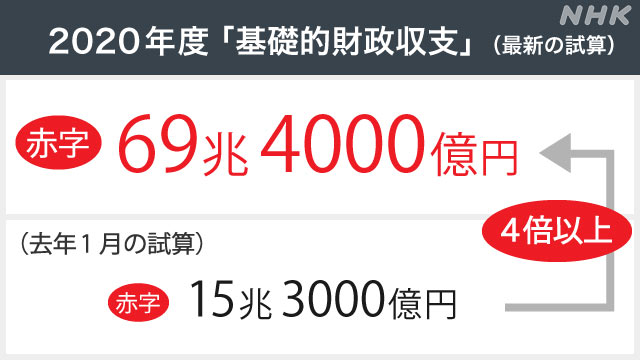At the Council on Economic and Fiscal Policy held on the 21st, the Cabinet Office presented the latest estimate of the "primary balance," which indicates the soundness of public finances.
This year, the deficit was 69.4 trillion yen, which is more than four times higher than the estimate shown one year before the spread of the new coronavirus, and the road to fiscal consolidation is becoming even steeper.
The government has set a goal of turning the index of "primary balance", which indicates how much tax revenues can be covered by tax revenues, into the black in 2025, without relying on government bonds for policy expenses.
According to the latest estimation released by the Cabinet Office on the 21st, this year's deficit was 69.4 trillion yen due to ▼ additional expenditures increased due to the response to the new coronavirus and ▼ tax revenues fell. It is supposed to be.
The amount of deficit has increased by 1.9 trillion yen from the estimate shown in July last year, and it has more than quadrupled from the estimate of 15.3 trillion yen shown in January last year before the spread of infection. The road to reconstruction is getting steeper.
Regarding the outlook for the future, ▼ Even if it is assumed that economic growth will continue to be high by about 2% annually, the government will aim for a surplus in 2025 with a deficit of 7.3 trillion yen, and it will be four years from the target It is said that it will be late in 2029.
Furthermore, assuming that economic growth is about 1% per year, the deficit will be 12.6 trillion yen in 2025, and even in 2030, the final year of the trial calculation, the deficit of 10.3 trillion yen will still remain. is.
Achieving the government's goal of becoming profitable in 2025 is extremely difficult, but if the new coronavirus hits the economy for a long time, the financial situation may continue to deteriorate due to further fiscal mobilization and lower tax revenues. I am concerned.
Debt balance also swells significantly 2.16 times gross domestic product
As a result of continuing large-scale fiscal mobilization in response to the new coronavirus, the debt balance has also increased significantly.
According to the latest estimation released by the Cabinet Office on the 21st, the total debt balance of the national and local governments will reach 1159.8 trillion yen at the end of this fiscal year.
This is ▼ 13.3 trillion yen from the estimate in July last year, ▼ 79.1 trillion yen more than the estimate in January last year before the spread of infection, and the scale of debt is GDP = 2.16 of gross domestic product. It will be doubled.
The government has also set a goal of steadily reducing the ratio of debt to GDP for fiscal consolidation.
▼ Assuming that economic growth of about 2% per year will continue in real terms, the ratio of debt balance will be less than double in 2023 because the expansion of GDP will exceed the pace of debt increase, and 2030, the final year of the estimation. It is expected to decrease 1.68 times in the fiscal year.
▼ On the other hand, assuming that economic growth is about 1% per year, it is a strict estimate that the debt balance ratio will not fall below double even in 2030.
The financial situation of each country is also deteriorating.
As a result of large-scale fiscal mobilization in countries other than Japan in response to the new coronavirus, public finances are rapidly deteriorating.
Even under such circumstances, the financial difficulty of Japan in terms of indicators stands out.
According to the IMF = International Monetary Fund, the ratio of debt balances to GDP in each country is estimated as of October last year (2020), and is more than 22 points higher than the end of December in the United States before the spread of infection (2019). 131.1%, ▼ France increased by more than 20 points to 118.7%, ▼ United Kingdom increased by more than 22 points to 108%, ▼ Germany increased by more than 13 points to 73.2%, ▼ China increased by more than 9 points. It is 61.7% and so on.
On the other hand, ▼ Japan has risen by more than 28 points to 266.1%, and the ratio of debt balance is outstandingly high, and the rate of increase is also higher than in other countries.
Regarding the deterioration of public finances around the world, the Cabinet Office has said that it poses a risk to the world economy, saying that "there may be questions about fiscal sustainability in the medium to long term."

